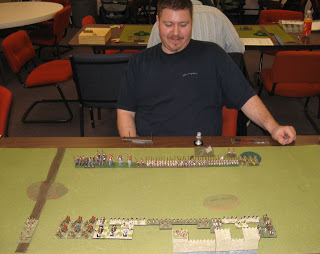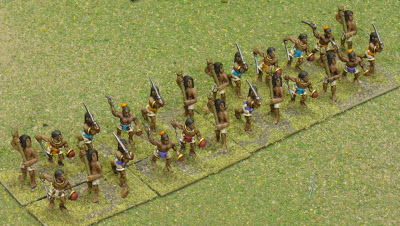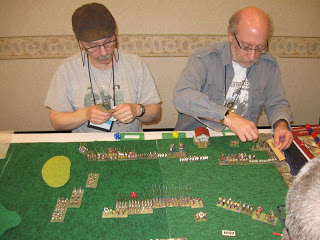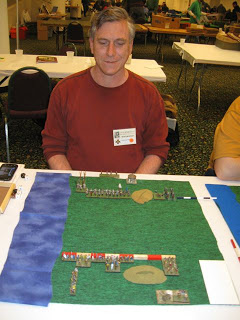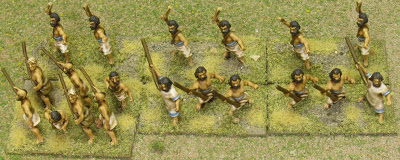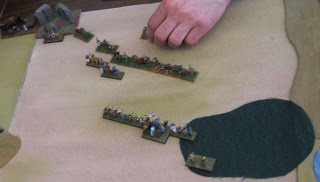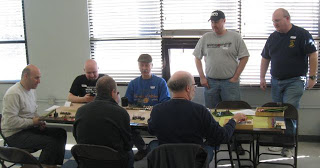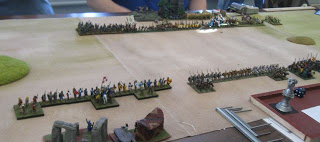Stoogecon was a few weeks ago. As with last year’s event, the tournaments were three rounds long: an Open and Matched Pairs. Unlike in previous years, the DBM folks showed up as well, and even managed to get as many players as “we” (the DBA players) did. Although I mainly want to share my thoughts about my choice of Matched Pair armies, I’ll start with a summary of the day.
In the Open, we apparently all had the same idea: “everyone likes medieval knight armies, so I’ll take elephants.” I brought Rajput Indians, III/10b. The other players had Tamil Indians, Graeco-Indian, Southern Dynasty Chinese, New Kingdom Egyptians, and Romans.
A quick summary of my Open games: In round 1, Frank with Tamil Indians beat me in a close and hard-fought match, 4-3. In round 2, I shouldn’t have gone into the bad going, and Rich’s Chinese punished me for it, 4-1. In the last round, Larry’s Egyptians ran up to me and committed ritual suicide: I won 2g-0 on the bound Larry first contacted me.
For the Matched Pairs event, I chose Early Bedouin, I/6c, vs. Later Achaemenid Persian, II/7. Bedouins have: 3x3Cm (Gen), 1x2Cm, 4x3Ax, 4x2Ps. I gave the Persians 1xLCh (Gen), 2x3Cv, 2xLH, 4x3Ax, 3x2Ps. The basic difference is the Bedouin camels are better vs. mounted, but there are fewer of them. Bedouins have the possibility of Dunes, but with Ag: 3 to 1 they’ll rarely get to use them.
So, is this a well-matched pair? I’ll share my thoughts after a summary of the event.
In the first round, I played against Jim using his armies: I played Middle Imperial Romans vs. his Later Imperial Romans. I didn’t feel like I made any big mistakes during play, but still ended up continuing my losing streak against him: 4-0.
In the second round, we used my armies, and JM chose Bedouins. These armies have low combat factors, so they’re fast and bloody. I don’t remember the details of the battle, but it was a total rout: I won 6g-1.
In the third and final round, we played my armies again and Frank chose the Persians. Surprisingly, the Bedouins won terrain and of course placed some big central dunes. That whole “rout” thing worked so well, I tried it again… only this time I was Bedouin, so I lost 5-2.
At this point my conclusion may be obvious, but I first want to make it clear that I really enjoy playing either one of these armies against the other. I’ve had some tense and interesting games, and even the routs didn’t look totally hopeless until the dice started rolling. Using primarily light troops means you run faster, so you get into combat faster with less time to rearrange lines before contact; and the low combat factors mean someone dies quickly. You’ll never end up with an incomplete game, in any case.
The basic premise of this matched pair is to take two similar but slightly different armies, with similar compositions but relative strengths and weaknesses. Bedouin camels have an advantage against mounted but a penalty against foot, and don’t suffer bad going penalties if they happen to find a dune to stand in. Persians have more mounted, but less bad going troops.
Despite these seemingly even odds, I don’t think I’ve ever seen the Bedouins win. It can certainly be done, and there have been some close games, but overall I don’t think the pair is as well-matched as I used to. After Stoogecon, I considered why this might be, and came up with a few ideas.
First of all, “dunes” are mostly a red herring. Bedouin will rarely get a chance to place dunes at all, only 6/36 of the time. If you do get dunes, they can probably be used effectively, but I haven’t done it correctly yet. The benefit of dunes in this matchup is not that camels fight in them without penalty; it is the camels’ ability to move through dunes as a group. No Persian player would be dumb enough to put their Cavalry near the dunes, so the camels will only be facing foot… but the camels aren’t very good against foot. So, deploy the dunes for disruptive PIP advantage, rather than as a central terrain to fight over.
The other problem is the nature of the armies’ advantages. Bedouin camels are better against cavalry, which is 5 elements; but they’re worse against foot, the other 7 elements. Their advantage turns a cavalry matchup from 3-3 into a 4-3, which increases their odds of a kill from 2/36 to 4/36 and a recoil from 15/36 to 21/36. Their disadvantage against supported auxilia goes from 3-3 to 2-3: 2/36 chance of being killed up to 6/36, and 15/36 recoil up to 21/36. Against unsupported auxilia, 3-2 to 2-2 reduces the chance of a kill from 6/36 to 4/36, while increasing the chance of being killed from 1/36 to 4/36.
So basically, Bedouins get a lesser advantage against fewer foes, and a larger disadvantage against more foes.
The overall dynamic is that the Persians are happy playing with their entire force out in the open, while the Bedouins want to keep their foot in bad going to stay away from the enemy Cavalry. They have to choose to either stay in bad going and give the Persians both numerical advantage in the open and overall PIP advantage; or to come into the open and give the Persians combat factor advantage
Not all of these factors played into every loss I’ve seen, but in my previous attempts to use this matched pair I came away with similarly skewed result.
Overall, I have a bit of a dilemma. I really enjoy playing this pair of armies, but I no longer think it’s an even match. I either need to figure out how to win with Bedouin, since I already know how to win with Persia; or find another matched pair that I enjoy playing as much as this one even when I’m losing. Any ideas?




